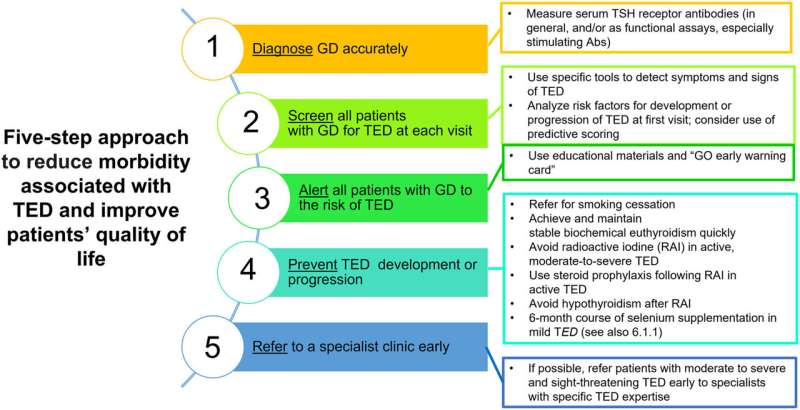Steps to reduce morbidity and improve quality of life in patients with TED. Measures to reduce morbidity associated with TED and improve patients’ QoL. (This figure is used and adapted with permission, courtesy of the British Thyroid Foundation, from the Thyroid Eye Disease Amsterdam Declaration Implementation Group UK (TEAMeD) (https://www.btf-thyroid.org/teamed-page) and Dr Anna Mitchell. Further description of the Thyroid Eye Disease Amsterdam Declaration is available (17, 20)). Abs, antibodies; GD, Graves’ disease; RAI, radioiodine; TED, thyroid eye disease. Credit: European Thyroid Journal (2022). DOI: 10.1530/ETJ-22-0189
The American Thyroid Association (ATA) and European Thyroid Association (ETA) have collaborated on the "Management of Thyroid Eye Disease: A Consensus Statement by the American Thyroid Association and European Thyroid Association." This consensus statement, prepared as a clinical resource for endocrinologists, is now available online and has been co-published in the journals Thyroid and the European Thyroid Journal.
The consensus statement was drafted by a multidisciplinary, global writing task force led by co-chairs from both societies, including Henry B. Burch, MD, Program Director, Division of Diabetes, Endocrinology, & Metabolic Diseases, National Institutes of Health, National Institute of Diabetes and Digestive and Kidney Diseases, and Petros Perros, MD, Honorary Consultant in Endocrinology at Newcastle upon Tyne Hospitals NHS Foundation Trust.
The final document integrates feedback from patients and the ophthalmology community, comments from ATA and ETA members, and it underwent formal peer review in Thyroid and the European Thyroid Journal. Potential conflict of interest was managed, and transparency maintained in formulating the consensus statement.
"This carefully crafted statement, written by experts of the two sister societies, provides an up-to-date overview of the management of TED, which can present a challenging clinical problem. Integrating the latest developments, it is an excellent guide for specialists caring for patients with Graves' disease and emphasizes the need for a multidisciplinary approach for individuals with severe forms of TED," says Peter A. Kopp, MD, immediate past president of the ATA.
Thyroid Eye Disease (TED) is relatively rare but causes significant morbidity, impaired quality of life, and is associated with excess socioeconomic burden. The publication of the "Management of Thyroid Eye Disease: A Consensus Statement by the American Thyroid Association and European Thyroid Association" is timely, as novel treatments are rapidly evolving, thus expanding treatment options.
The key objective was to create a synopsis to promote delivery of evidence-based care for patients with TED, and those at risk of developing it. The task force considered all treatments including new and emerging therapies, striving to adjudicate inconsistencies and identify gaps in the current literature. The available evidence was translated into practical recommendations for endocrinologists.
The consensus statement emphasizes the importance of early diagnosis, appropriate and timely referral to specialty care, joint management by clinical teams with expertise in both endocrinology and ophthalmology, and outlines a roadmap to personalized care. It also highlights important areas of future research.
"This outstanding collaborative effort between the European and American Thyroid Associations includes all the latest evidence and clinical experience from renowned international experts. The result is a superb clinical guide covering the multidisciplinary care of thyroid eye disease that is practical, timely and highly relevant to specialists all over the world," says Graham R. Williams FRCP, Ph.D., FMedSci, president of the ETA.
The consensus statement is expected to be a useful reference tool for practicing endocrinologists globally. The consensus statement does not establish a standard of care and specific outcomes are not guaranteed. Treatment decisions must be made based on the independent judgment of health care providers and each patient's individual circumstances. A consensus statement is not intended to take the place of physician judgment in diagnosing and treatment of particular patients.
More information: Henry B. Burch et al, Management of Thyroid Eye Disease: A Consensus Statement by the American Thyroid Association and the European Thyroid Association, Thyroid (2022). DOI: 10.1089/thy.2022.0251
Henry B Burch et al, Management of thyroid eye disease: a Consensus Statement by the American Thyroid Association and the European Thyroid Association, European Thyroid Journal (2022). DOI: 10.1530/ETJ-22-0189
Provided by American Thyroid Association
























